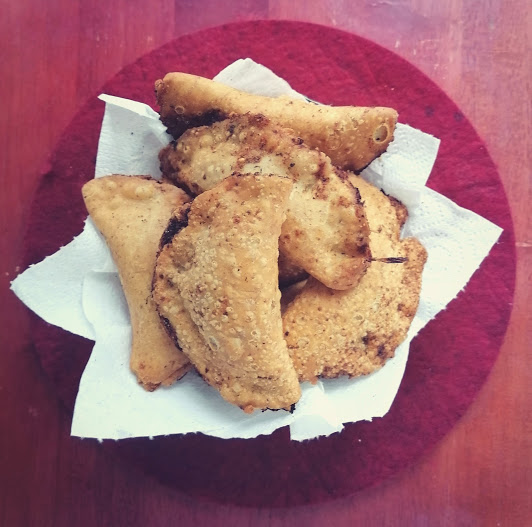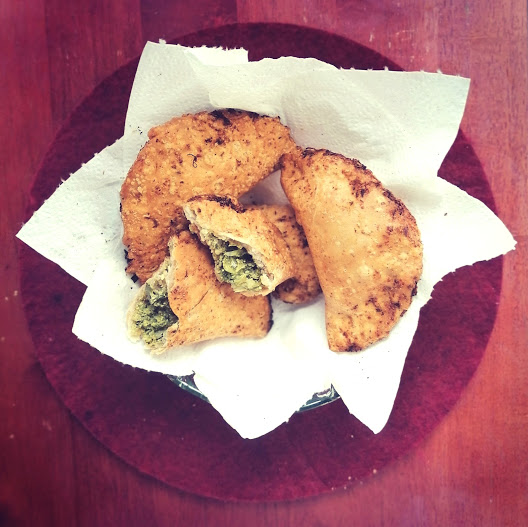| Preparation time: 1 hour | Cooking time: 20 minutes |
| Serves: 6 (makes about 18) | Difficulty: Moderate |
Ingredients
For the pastry:
- 200g/7oz/just over 1 1/2 cups of plain flour, plus extra for dusting
- 3 tablespoons of olive oil
- A pinch of salt
- 1 egg
- 3 tablespoon of water
For the filling:
- A tablespoon of olive oil
- 2 shallots
- 100g/3 1/2 oz/just under half a cup of spinach leaves
- 340g/12 oz/1 bunch of Swiss chard leaves, stems removed (use bok choy, cavolo nero or leeks as a substitute for Swiss chard if you can’t get ahold of it)
- 2 tablespoons of ricotta OR boiled rice
- A tablespoon of grated Parmesan
- A pinch of salt and pepper
- 2 eggs
For frying:
- 1 egg
- Olive oil
Make it vegan: Use 2 tablespoons of boiled rice or silken tofu instead of ricotta, and use a tablespoon of vegan cheese instead of Parmesan– or try using homemade vegan ricotta and Parmesan. Use four tablespoons of silken tofu, vegan ricotta, or scrambled egg substitute (like VeganEgg or Scramblit) instead of the eggs in the filling, and use aquafaba or flax egg instead of the egg in the pastry and the egg used to stick the pastries together.
Special Equipment
- A sieve
- A large mixing bowl
- A large saucepan
- A frying pan
- A rolling pin
- A 4cm cookie cutter
Method
- To make the pastry, sieve the flour into a large mixing bowl and add the salt, egg, olive oil and water. Mix everything together thoroughly to form a ball of dough.
- Sprinkle some flour onto a clean surface and turn the dough out onto it. Knead it for about 5 minutes, until the dough is smooth. If it seems too crumbly, add a little more cold water, and if it’s too wet, add some more flour.
- Return the dough to the mixing bowl and cover the bowl with a tea towel. Pop it in the fridge to chill for 30 minutes.
- Meanwhile, set a frying pan over a medium heat. Add a tablespoon of olive oil and the shallots, and sauté them for a couple of minutes, stirring occasionally.
- Add the spinach and Swiss chard to the pan with the shallots. Sauté the vegetables for a further 5 to 10 minutes, stirring occasionally, or until the vegetables are tender.
- Remove the pan from the heat and allow its contents to cool for a few minutes. Then add the ricotta or boiled rice, Parmesan, salt, pepper and eggs to the pan and stir everything together thoroughly.
- Sprinkle some flour onto a clean surface. Use a rolling pin to roll out the pastry. It should be about 5mm thickness.
- Use the 4cm cookie cutter to cut out little circles of dough, then roll each circle out more until it’s about 8cm in diameter. Repeat until you have used up all the dough- you should end up with about 18 circles.
- Drop a teaspoon of filling to the centre of each circle. Beat the remaining egg and use a pastry brush to brush it around the edge of each circle. Then fold each circle in half to form semi circles. Press the edges down and seal the pastries with a fork.
- Add some olive oil to a saucepan- it should be at least 8cm deep. Set it over a high heat and heat the oil until it’s about 180’C (or until a bit of pastry dropped into the oil quickly bubbles and begins to brown.)
- Lower a couple of pastries into the oil at a time and fry them for about 5 minutes, or until they’re very hot and golden brown. Repeat until all the pastries have been cooked.
- Serve the Barbajuan immediately, while they’re very hot.
- Bon Appetit!
Tips
- If you like you can keep any cooked Barbaguian warm in the oven while the rest are being fried before serving.

Background
Home: Monaco, Northern Italy, French Riviera
Pronounciation: (Bar-bah-Jean)
Relatives: Cornish Pasty (Cornwall), Pierogi (Poland),
History
Monaco’s culinary history is interwoven with that of the neighbouring French Riviera and Italian region of Liguria. All three sit on the Mediterranean coast and enjoy its warm climate, so fish and seafood, as well as fresh fruit and vegetables, are abundant and used in many of their recipes. The Swiss chard used in Barbiguian, for example, is also the key component in another Monégasque dish, Swiss Chard Pie. Barbagiuan itself is very popular in the French Riviera, Monaco and Liguria, and in the latter is often stuffed with pumpkin instead of Swiss chard.
Barbagiuan means ‘Uncle John’ in Monégasque. It is named after its supposed creator, a man named Jean (John.) According to legend, Jean was a man who wanted to make ravioli but, realizing he didn’t have anything to use as filling, stuffed his ravioli with Swiss chard and tried frying it. His creation proved to be tasty and popular, and became known as Barba–Giuan (‘Uncle John’) in his honour.
It remains a very popular Monégasque appetizer, and is widely available at Monacan markets. Being Monaco’s national dish it is also a key part of Monaco’s national holiday, La Fête du Prince (November 19th), and is now specifically celebrated at Monaco’s La Fête du Barbagiuan, where attendees can enjoy Barbagiuan cooking demonstrations, culinary classes and Barbagiuan-related events.

Georges Jansoone, Monaco003, 2009 https://commons.wikimedia.org/wiki/File:Monaco003.jpg [acessed 13/08/2020] (https://creativecommons.org/licenses/by/3.0/deed.en)

That sounds delicious. Monaco had a fleet, and, I guess, trade across the Mediterranean in the middle ages. This could be a Monagesque adaptation of the Levantine Fittir or Fetayr.
LikeLiked by 1 person
It’s really tasty! I’m going to have to look up the Fittir/Fetayr and find a recipe for it, Levantine food is amazing 🙂
LikeLiked by 1 person